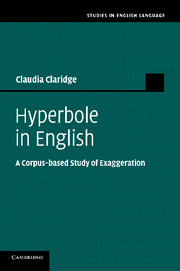Book contents
- Frontmatter
- Contents
- List of figures
- List of tables
- Acknowledgements
- 1 Introduction
- 2 The characteristics of hyperbole
- 3 Realisations of hyperbole
- 4 Using hyperbole: the speaker perspective
- 5 Hyperbole in interaction
- 6 Conventionalisation
- 7 The rhetoric of hyperbole
- Conclusion
- Appendix 1 Modern corpora used (Chapters 1, 2, 3, 4, 5 and 6)
- Appendix 2 Modern sources other than corpora (Chapters 2, 3, 4 and 5)
- Appendix 3 Conventionalisation in dictionaries (Chapter 6)
- Appendix 4 Corpora, dictionaries and texts used for the diachronic investigation (Chapter 6)
- Appendix 5 Sources used in Chapter 7
- References
- Index
4 - Using hyperbole: the speaker perspective
Published online by Cambridge University Press: 04 February 2011
- Frontmatter
- Contents
- List of figures
- List of tables
- Acknowledgements
- 1 Introduction
- 2 The characteristics of hyperbole
- 3 Realisations of hyperbole
- 4 Using hyperbole: the speaker perspective
- 5 Hyperbole in interaction
- 6 Conventionalisation
- 7 The rhetoric of hyperbole
- Conclusion
- Appendix 1 Modern corpora used (Chapters 1, 2, 3, 4, 5 and 6)
- Appendix 2 Modern sources other than corpora (Chapters 2, 3, 4 and 5)
- Appendix 3 Conventionalisation in dictionaries (Chapter 6)
- Appendix 4 Corpora, dictionaries and texts used for the diachronic investigation (Chapter 6)
- Appendix 5 Sources used in Chapter 7
- References
- Index
Summary
The occurrence of hyperbolic expressions and the form they take is the result of a speaker's choice.1 The present chapter will thus look more closely at speakers' usage of hyperbole, in particular dealing with the following questions:
How frequently do speakers opt for a hyperbolic expression? Corpus data can give information on the overall frequency as well as, to a certain extent, on the degree of use by certain social groups. (Sections 4.1 and 4.2)
Why do speakers choose to use hyperbolic formulations? This leads us to an analysis of subjectivity in language use. The particular reasons or motivations on which to focus here are the expression of affective meaning, self-presentation and the interest value of speakers and their communications. (Section 4.2)
What types of hyperbolic expression are used, going beyond the semantic and syntactic classification used in Chapter 3? Here the degree of conventionality or creativity of hyperbolic expressions will play a role. (Section 4.2)
How do speakers frame or ‘package’ their overstated usages in context? Speakers can choose to downtone or emphasise their overstatements, they can reassert them, modify them or retract them. They can, furthermore, use explicit hyperbole in order to comment on their own or other speakers' use of language. (Sections 4.3 and 4.4)
Frequency of hyperbolic expressions
The discussion of frequency presented here makes use of the BNC subcorpus, and partly also the SBC, as introduced in Chapter 3.
- Type
- Chapter
- Information
- Hyperbole in EnglishA Corpus-based Study of Exaggeration, pp. 71 - 129Publisher: Cambridge University PressPrint publication year: 2010



